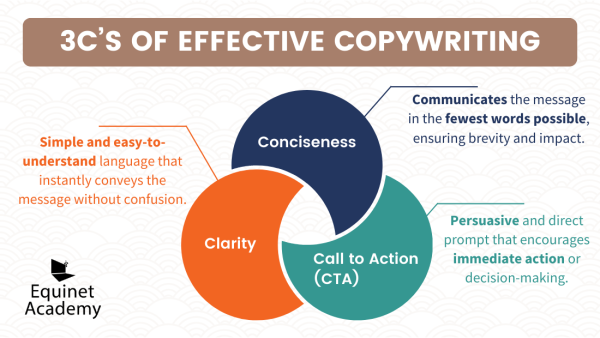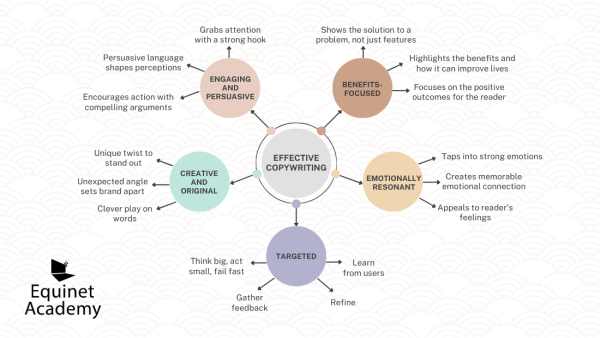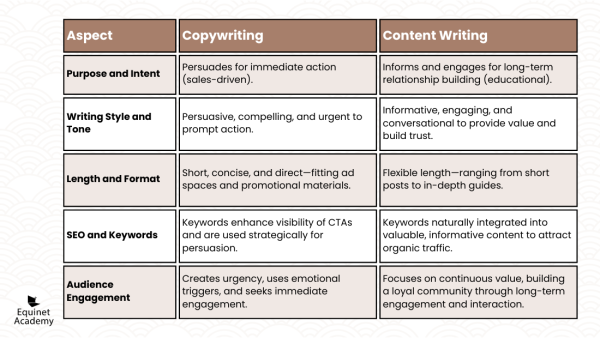Have you been using copywriting and content writing interchangeably? If so, you might be doing your business a huge disservice.
Copywriting and content writing are completely different skill sets, but you’d need both if you want your marketing strategy to be successful.
In the constantly evolving world of digital media, writing is a vital part of communicating and marketing. As you go through websites, social media platforms, and email campaigns, you’ll constantly encounter these two powerful forms of writing.
Both copywriting and content writing play crucial roles in digital marketing, but they serve different purposes and follow distinct strategies.
Imagine you’re on a website, looking for a product you’re interested in purchasing. The catchy phrases that grab your attention and the compelling product descriptions that make you consider a purchase are the handiwork of a copywriter.
Copywriting is like the spark that ignites interest and encourages action. It’s the persuasive voice that guides you towards making a decision, whether it’s buying a product, signing up for a newsletter, or simply clicking on a link.

Image source: Trello
Now, picture yourself reading an informative blog post, an engaging how-to guide, or an insightful article.
That is content writing in action. It’s like a friendly conversation with an expert who’s sharing knowledge, offering value, and building a relationship with you. Content writing aims to educate, inform, and engage, helping to establish trust and credibility between you and the brand.

Image source: Zomato
The digital marketing world relies heavily on both copywriting and content writing to connect with audiences like you.
Copywriting is often the driving force behind direct sales and conversions, using persuasive techniques to motivate immediate action.
Content writing, however, focuses on long-term engagement, aiming to provide valuable information that enriches your understanding and keeps you coming back for more.
The purpose of this article is to shed light on the key differences between these two essential writing styles. By understanding what sets them apart, you’ll be better equipped to appreciate the nuances of digital marketing strategies and how they’re employed to capture your interest and earn your trust.
Whether you’re a budding writer, a business owner, or simply a curious reader, gaining insight into copywriting and content writing will improve your comprehension of the digital content you encounter daily.
So, let’s dig deeper into the unique features, objectives, and techniques that define copywriting and content writing.
Lastly, you’ll discover how they both contribute uniquely to the world of digital marketing.
Understanding Copywriting
Copywriting is an art form in the world of marketing and advertising, crafted with the precision of a skilled wordsmith to achieve one primary goal: action.
When you come across copywriting, it’s like having a conversation with a persuasive friend who knows exactly what to say to convince you to take the next step – whether it’s making a purchase, signing up for a service, or engaging with a brand in some meaningful way.
Basically, copywriting is about creating compelling, persuasive content that prompts your reader to act. This could be anything from clicking a “Buy Now” button, to exploring a new product, to joining an email list for exclusive offers.
The objectives of copywriting are clear: to grab the reader’s attention, ignite their interest, and drive them towards a specific action, all while reinforcing the brand’s message and values.
To achieve these goals, copywriters adhere to the 3 C’s: Clarity, Conciseness, and Call to Action.

- Clarity: The message must be clear and easy to understand. Copywriters use straightforward language to ensure that you grasp the message instantly, without any confusion. This is crucial because, in the digital world, attention spans are short, and clarity can be the difference between captivating and losing an audience.
- Conciseness: With conciseness, copywriters write their message in as few words as possible, making every word count. This brevity ensures that the message is not only digestible but also impactful, keeping the reader engaged and interested.
- Call to Action (CTA): Perhaps the most critical component, the Call to Action, is the directive that encourages you to take a specific step. A compelling CTA is direct, persuasive, and often creates a sense of urgency or excitement, pushing you towards making a decision.
In marketing and advertising, copywriting is the engine that powers all kinds of campaigns. You’ll find it in ads, sales emails, product descriptions, landing pages, and social media posts.
The primary role of copywriting is to bridge the gap between a brand and its audience, using persuasive language to convert interest into action. It’s about writing messages that resonate with the target audience on a personal level, making products or services seem not just appealing, but a need.
Effective copywriting possesses certain key characteristics that set it apart:
- Engaging and Persuasive: It captures your attention from the first line and holds it, using persuasive techniques to influence your perception and actions.
- Benefits-focused: Rather than just listing features, it highlights the benefits that matter to you, showing how the product or service can improve your life or solve a problem.
- Emotionally Resonant: Great copywriting often taps into emotions, creating a connection that goes beyond the rational to make the message more memorable and impactful.
- Targeted: It speaks directly to its intended audience, using language and references that resonate with that specific group, making the message more personal and relevant.
- Creative and Original: Standout copywriting often involves a creative twist, whether it’s a unique selling proposition, an unexpected angle, or a clever play on words, setting the brand apart from the competition.

Understanding copywriting is essential because you’ll find it all around you on the internet –influencing decisions and shaping perceptions of brands and products.
By recognising the strategies and techniques used in copywriting, the consumer is more informed and can appreciate the effort involved in creating these persuasive messages.
Whether you’re responding to a call to action, being influenced by a compelling product description, or simply enjoying an engaging ad, you’re seeing the art of copywriting at work as it guides you through the online marketplace.
Understanding Content Writing
Content writing, on the other hand, is the backbone of the digital landscape. It gives the structure and substance that inform, educate, and engage audiences across the web.
Unlike its persuasive cousin, copywriting, content writing focuses on creating valuable and relevant material that serves to inform, educate, and entertain, rather than directly sell.
This could be in the form of blog posts, articles, whitepapers, ebooks, and more. The primary goals of content writing are to attract and engage a target audience, provide them with valuable information, and establish a brand’s authority and trustworthiness in its field.
One of the key distinctions between content writing and creative writing lies in its objectives and structure. While creative writing delves into storytelling, exploring characters, emotions, and imaginative scenarios, content writing is anchored in reality, aiming to deliver factual, actionable, and useful information tailored to the reader’s needs and interests.
Creative writing is boundless in its scope, embracing fiction, poetry, and other forms of artistic expression, whereas content writing is purpose-driven, and designed to educate, inform, or solve specific problems within a defined context.
Content writing plays a pivotal role in several key areas:
- SEO (Search Engine Optimisation): Content writing is integral to any SEO strategy you want to deploy. By adding targeted keywords and phrases, structuring information for easy readability, and providing valuable content, you can improve a website’s visibility and ranking on search engines. This makes it easier for potential customers to find the content through organic search, driving traffic to the site.
- Education: Through informative and well-researched content, you can also educate your audience about various topics, from how-to guides and tutorials to in-depth analyses and case studies. This educational aspect helps your readers gain new insights, learn new skills, or understand complex subjects, establishing the brand as a knowledgeable and reliable source in its industry.
- Brand Building: Consistent, high-quality content will help build your brand’s voice and authority, promoting trust and loyalty among your audience. In addition, by consistently delivering valuable content, you can create a positive image and reputation which will encourage your readers to come back for more information. Over time, this will convert them into customers or advocates for your brand.
Key elements that make content writing compelling include:
- Value and Relevance: The content must address the needs, questions, or interests of the target audience, providing them with something of value. This could be solutions to problems, answers to questions, or new insights that enrich the reader’s understanding or skills.
- Clarity and Accessibility: Effective content is easy to read and understand, free from jargon or overly complex language, making it accessible to a broad audience. It’s structured in a way that readers can easily skim through, finding the information they need quickly.
- Engagement: While the primary goal may not be to persuade, engaging content captures the reader’s interest and keeps them reading. This can be achieved through a conversational tone, real-life examples, or compelling storytelling elements within the factual framework.
- Accuracy and Credibility: Content writing must be well-researched and accurate, citing reliable sources and providing factual information. This credibility is crucial for building trust with the audience and establishing the brand as an authority in its field.
- Optimisation for SEO: While the reader’s needs come first, incorporating SEO best practices without compromising content quality can enhance visibility and reach. This includes using relevant keywords naturally, optimising titles and headings, and ensuring the content is mobile-friendly.
Understanding content writing is essential in appreciating the depth and breadth of information available online. It’s the educational articles that expand your knowledge, the engaging blog posts that pique your curiosity, and the comprehensive guides that answer your burning questions.
Through content writing, brands not only inform and engage but also build lasting relationships with their audience, laying the foundation for trust, loyalty, and authority in their respective domains.
Key Differences Between Copywriting and Content Writing
As you cover the scope of copywriting and content writing, you’ll discover a landscape rich in diversity. Here each realm serves a unique purpose, uses distinct styles and tones, and follows different strategies for audience engagement and retention.
You need to understand these differences as it’s vital to appreciate how each contributes to the broader goals of digital marketing and brand communication.

Purpose and Intent:
- The primary difference lies in their core purpose and intent. Copywriting is sales-driven, designed to persuade you to take immediate action, such as making a purchase, signing up for a service, or clicking on a link. It’s the driving force behind advertising campaigns, promotional materials, and direct marketing efforts, where the goal is to convert interest into action swiftly.
- Content writing, on the other hand, is predominantly informative and educational. Its primary aim is not to sell directly but to inform, engage, and provide value to the audience. This could be through how-to guides, informative articles, educational content, or insightful blog posts. The intent here is to build trust, credibility, and authority, establishing a long-term relationship with the audience.
Writing Style and Tone:
- The writing style and tone further highlight the differences between the two. Copywriting often uses a persuasive, compelling, and sometimes urgent tone. This was designed to prompt an emotional response and encourage immediate action. The language is direct, benefit-focused, and uses psychological triggers to influence decision-making.
- On the contrary, content writing tends to be more informative, engaging, and conversational. It aims to draw you in with interesting, relevant content, maintaining a tone that’s accessible and relatable. The focus is on offering value that will enrich the reader’s knowledge or experience, and fostering a sense of community and trust around the brand.
Length and Format of Content:
- The length and format of the content also differ significantly between copywriting and content writing. Copywriting is often concise and to the point, fitting into the limits of ad spaces, email subject lines, or product descriptions. It needs to convey a compelling message in a limited space, making every word count.
- Content writing, however, can differ greatly in length, from short blog posts to extensive guides or reports. The format is more flexible, as this allows for a deeper investigation of topics, adding multimedia elements, and a structure that allows easy navigation and engagement with the content.
SEO Considerations and Keyword Usage:
- While both copywriting and content writing consider SEO to enhance online visibility, their approaches to keyword usage and optimisation can vary. In copywriting, SEO principles and keywords are included to improve the persuasive impact and visibility of the call-to-action elements, ensuring they reach a broader audience.
- In content writing, SEO is woven into the content more organically, focusing on creating valuable, high-quality content that naturally incorporates keywords and SEO best practices. The goal is to rank well in search engine results, attracting organic traffic through informative and engaging content that addresses the audience’s search queries and needs.
Audience Engagement and Retention Strategies:
Finally, the strategies for audience engagement and retention highlight the functional differences between copywriting and content writing.
- Copywriting seeks to create a sense of urgency, leveraging emotional triggers and persuasive tactics to drive immediate engagement and action. It’s about capturing attention quickly and compelling the audience to act on that interest without delay.
- Content writing, however, employs a different set of strategies to engage and retain the audience. It focuses on providing continuous value through quality content, encouraging readers to return for more information, engage with the content through comments or shares, and gradually build a loyal community around the brand. The engagement is more about depth and long-term interaction, rather than the immediate response sought by copywriting.
In summary, while both copywriting and content writing are essential components of effective digital marketing and brand communication, they serve different purposes and employ distinct strategies.
Copywriting is about immediate action and persuasion, using concise, impactful language to drive sales and conversions. Content writing, conversely, aims to inform, educate, and engage, using a more conversational and informative approach to build long-term relationships with the audience. Recognising these differences is key to leveraging each effectively in your digital marketing efforts, whether you’re looking to convert, inform, or engage.
Examples and Case Studies
Diving into the real world, let’s explore examples and case studies that highlight the practical applications, successes, and nuanced distinctions between copywriting and content writing. These instances will not only show their unique characteristics but also showcase instances where they intersect.
Real-World Examples
- Copywriting Example: Nike’s “Just Do It” campaign is a quintessential example of copywriting brilliance. This simple yet powerful slogan captures motivation, action, and the brand’s ethos in just three words, urging consumers to push beyond their limits, side by side with the decision to buy Nike products.

Image source: NPR
- Content Writing Example: HubSpot’s Blog is a prime example of content writing that provides immense value to its audience. Covering topics from inbound marketing to sales strategies, the blog offers in-depth articles, guides, and resources, establishing HubSpot as an authority in its field and building a loyal community of readers.

Image source: Hubspot
Analysis of Successful Campaigns
- Copywriting Success: Apple’s product launch campaigns masterfully employ copywriting to generate excitement and anticipation. By highlighting the innovative features and sleek design of new products with compelling copy, Apple creates a narrative that these aren’t just gadgets; they’re must-have lifestyle enhancements.
- Content Writing Success: The WSQ Search Engine Optimisation (SEO) Course is a content writing masterpiece that has garnered widespread acclaim. This comprehensive guide breaks down complex SEO concepts into digestible, easy-to-understand sections, attracting novices and experts alike, significantly boosting Equinet’s credibility and user base.
Content Copywriting Examples
- Crossover Example: Airbnb’s neighbourhood guides blend content writing with copywriting elements. These guides provide valuable information about different neighbourhoods for travellers, filled with persuasive language that highlights the unique experiences Airbnb offers, subtly nudging readers to book their next stay.
- Distinction Example: A blog post on “10 Tips for Sustainable Living” vs. a promotional email for eco-friendly products. The blog post (content writing) educates readers on sustainable practices, engaging them with useful information, while the email (copywriting) uses persuasive language to drive sales of eco-friendly products, demonstrating the distinct goals of each writing style.
These examples and case studies show the effectiveness of both copywriting and content writing in engaging audiences, driving action, and building brand authority.
They also highlight the crossover potential, where elements of each can be woven together to create compelling narratives that both inform and persuade. Understanding these dynamics is crucial for leveraging the strengths of each in marketing strategies and campaigns.
Career Paths and Skills Development
Navigating the career paths of copywriting and content writing opens up a world of opportunities, each with its distinct roles, responsibilities, and rewards. Understanding these differences, along with the potential for transition and skill development, is key for those aspiring to carve out a successful career in either field.
Roles and Responsibilities
Copywriter:
Creates persuasive content aimed at driving sales or actions, such as ads, product descriptions, and marketing emails.
Works closely with marketing teams to develop creative concepts and compelling messages that align with campaign goals.
Needs to have a strong understanding of consumer psychology and the ability to write clear, concise, and persuasive copy.
Content Writer:
Produces informative and engaging content, like blog posts, articles, whitepapers, and ebooks, aimed at educating and engaging the audience.
Often responsible for researching topics, maintaining a consistent brand voice, and ensuring content is SEO-friendly to maximise reach.
Requires excellent research skills, a knack for storytelling, and the ability to break down complex information into digestible content.
Salary Comparison
Salaries for copywriters and content writers can vary widely based on experience, location, and the industry they work in. Generally, copywriters may command higher salaries due to the direct impact of their work on sales and conversions.
However, experienced content writers with specialised knowledge or expertise in high-demand niches can also achieve significant earnings.
Transitioning Between Copywriting and Content Writing
Transitioning between copywriting and content writing is not only possible but also quite common. The foundational skills of writing, research, and audience understanding apply to both fields. A copywriter looking to transition into content writing would need to hone their skills in long-form content creation and SEO, while a content writer moving to copywriting should focus on mastering persuasive techniques and understanding consumer psychology more deeply.
Skills and Courses for Aspiring Writers
For those looking to dive into these careers, several skills and courses can pave the way:
Core Skills:
Excellent writing and editing abilities
Strong research skills
Understanding of SEO principles
Ability to adapt tone and style for different audiences and purposes
Knowledge of consumer psychology (especially for copywriting)
Recommended Courses:
For Copywriting:
Introduction to Copywriting courses cover the basics of persuasive writing
Consumer Behaviour or Psychology courses to understand what drives decision-making
Marketing and Branding courses to grasp how copywriting fits into broader campaigns
For Content Writing:
WSQ Digital Content Marketing course and WSQ Search Engine Optimisation (SEO) courses are a good ways to learn how to optimise content for search engines and engage audiences
Writing and Journalism courses that focus on storytelling, structure, and engaging readers
Niche-specific courses, such as Technical Writing or Medical Writing, for those interested in specialised fields
By focusing on these areas of development, aspiring copywriters and content writers can build a strong foundation for a successful career. Whether you’re drawn to the persuasive allure of copywriting or the informative depth of content writing, honing your craft and continuously learning about your audience and the latest industry trends will be key to your success.
Which is Better? Copywriting or Content Writing
Deciding whether copywriting or content writing is better is like comparing apples and oranges; both are essential, yet they serve different purposes depending on the context of business needs, the target audience, and specific marketing goals.
Contextual Considerations
- Business Needs: The nature of the business and its products or services play a significant role. For instance, a new startup looking to generate buzz and immediate sales might lean more toward copywriting, while an established brand focusing on community building and authority might invest more in content writing.
- Audience: Understanding the target audience is crucial. A younger, action-driven demographic might respond better to the direct approach of copywriting, whereas a more analytical audience might appreciate the depth and value provided by content writing.
- Goals: Short-term goals like boosting sales for a new product launch are well-suited to copywriting. Long-term goals, such as building brand loyalty and establishing thought leadership, are effectively achieved through content writing.
Synergy in Marketing Strategy
In a comprehensive marketing strategy, copywriting and content writing are not mutually exclusive but rather complementary.
Engaging content can nurture the audience, building interest and trust, which copywriting can then capitalise on to drive conversions.
This synergy ensures a holistic approach, catering to both immediate business needs and long-term brand development.
Dual Skill Set
It’s entirely possible and increasingly common to wear both hats as a copywriter and content writer. This dual skill set allows for greater flexibility in addressing a wide range of marketing needs and adapting to various project requirements. Developing competencies in both areas can enhance a writer’s versatility, making them a valuable asset to any marketing team.
In essence, neither copywriting nor content writing is inherently better than the other; their effectiveness is context-dependent. A balanced approach, leveraging the strengths of each while understanding their unique contributions, can lead to a more robust and successful marketing strategy.
Conclusion
In wrapping up our exploration of copywriting and content writing, we’ve uncovered their unique characteristics, purposes, and the pivotal roles they play in the tapestry of digital marketing.
Copywriting, with its sharp focus on persuasion and action, contrasts with content writing’s aim to inform, educate, and engage.
Yet, despite these differences, they intersect beautifully within a comprehensive marketing strategy, each enhancing the other to create a rich, multifaceted narrative for brands and their audiences.
Understanding copywriting and content writing is crucial for anyone looking to excel in communication and marketing. Recognising when to employ the concise, compelling nature of copywriting versus the depth and engagement of content writing can make the difference in achieving immediate sales goals or building long-term brand loyalty and authority.
In the ever-evolving digital marketing landscape, the ability to adapt and skillfully wield both writing forms not only broadens a professional’s toolkit but also deepens their impact, ensuring messages reach their intended audiences and resonate with them profoundly.
In conclusion, whether you lean towards the persuasive allure of copywriting or the informative richness of content writing, mastering both is a gateway to more effective, dynamic, and successful marketing communications.
Additional Resources
For those eager to dive deeper into the worlds of copywriting and content writing, a wealth of resources awaits. Here are some curated recommendations to further your learning and mastery in these fields:
We offer a variety of courses tailored to beginners and advanced copywriters alike, focusing on persuasive techniques and effective sales copy. If you would like to gain effective writing techniques to engage your audience and get them to take action, Equinet Academy offers the WSQ Copywriting and Content Writing course.
These resources serve as a launchpad into the nuanced art and science of copywriting and content writing. Whether you’re just starting or looking to sharpen your skills, delving into these books, courses, and websites can provide valuable insights, techniques, and inspiration to excel in the dynamic field of digital marketing.
Never Miss a Post
Receive the latest blog articles right into your inbox.
Chris Minjoot
Chris is a senior Marketing & Communications professional with over 31 years’ experience as both an in-house practitioner and as a consultant servicing clients from a wide range of industries. He possesses the unique combination of strategic, creative, technical and writing skills critical for today’s integrated marketing needs. Chris is currently also the lead trainer for the Copywriting and Content Writing Course here at Equinet Academy.



Reader Interactions